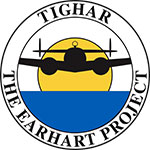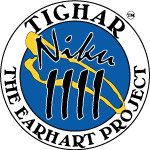After three and a half days at sea, Nai’a turned
the corner into the harbor at Pago Pago about 1 p.m. local time
on Friday and was finally still for the first time since leaving
Nikumaroro. While the passage did not rival that of 1997, when
forty foot seas were the order of the day, it was very rough indeed,
and everyone was heartily glad to go ashore. Watching water tower
above one’s head is not really so much fun.
The last day on the island was spent in the village,
by both necessity and plan. Both boats were out of the lagoon,
which meant no intra-island transportation; and the team needed
to look at the village carefully to try to match artifacts and
materials found at the Seven site.
Remember that the Seven site is multi-layered. There
is possibly some prehistoric activity; certainly castaway activity;
certainly Gilbertese/Gallagher activity; certainly Coast Guard
activity... and so on. In order to understand the layers and units
correctly, it’s important to know, if possible, what came from
where and even how.
Things found in the village that appear to match
artifacts or items found at the Seven site are:
Fine mesh copper screening.
The screening found in the village is very similar to that found
at the Seven site. It is not, however, in context – it is simply
lying about, not part of anything. Possible uses for screening
in the village would be to cover windows; to cover water barrels;
in cooking; and so on. However, because none of these uses were
seen in the village, we can’t know for sure that it is actually
part of the village life. It may be that there is some cache of
screening somewhere on the island that both the castaway and the
villagers found and made use of. There is some copper screening
at the Loran station, but it is much heavier gauge.
Green roofing material.
This stuff is an old fashioned kind of roofing material that incorporates
tarpaper and shingling into one unit, and comes in rolls. It’s
the sort of thing that might be used to roof a shed. Two pieces
of it were found in the village, nailed to the side of the radio
shack... which was built in the early 1950s. There is no evidence
that more of it was nailed to the shed and is now gone. Quite a
lot was found at the Seven site. Definitely one of those Nikumaroro
mysteries.
Corrugated metal sheeting.
There is quite a bit of this around the village; it was a popular
roofing material. It is found both in the lighter and the heavier
gauge.
Asbestos sheeting.
This is incorporated into a number of buildings in the village,
including the cistern which was one of the earliest structures
on the island. It also was used to make shutters for the cookhouse.
We think we can say that it is likely that the search party brought
some of this to the Seven site for whatever reason.
After working in and around the village for several hours, the
team sat down to eat some lunch near Gallagher’s grave, where there
were still some palm fronds scattered about from the memorial service.
One by one they laid down,
“just for a moment,” and about an hour later decided
that the expedition was over. Everyone packed up, called the ship’s
boat, and went aboard, the adrenalin rush thoroughly spent.
On Saturday, the FedEx folks came over with a truck
and loaded up everything to go to their warehouse. Today the team
was going to spend the day packing everything – EVERYTHING –
for shipment home, leaving everyone, if possibly, with only one
or two smallish carry-ons with which to tackle the airlines. The
flight out is at 2340 local time tonight, heading for Honolulu.
If all goes well, everyone will be home either Tuesday or Wednesday,
depending on their individual travel arrangements. |



